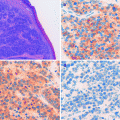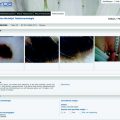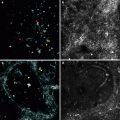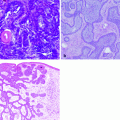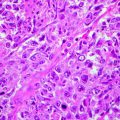Fig. 35.1
(a) Scheme of the FIDE system. (b) An exemplificative outcome of the search for similar pigmented skin lesions
The statistical analysis performed in order to assess the similarity among image items is based on a hierarchical Bayesian model-based data analysis approach. The RGB signal level model p(D) is linked to a high-dimensional primitive descriptor level p(P) taking into account the color as well as geometric information extracted from the data and in turn to a secondary, lower-dimensionality, independent synthetic descriptor level p(S) by conditional probabilistic links p(P|S), p(S|P). Inference is conducted in order to obtain the posterior density p(S|P) p(P|D) p(D). The obtained densities are compared with each other taking into account a bank of distance and divergence measures to carry out an association level search procedure. Category search is employed to limit search results discriminating among retrieval outcomes of different natures. Standard measures of retrieval performance are considered in the development and evaluation of the system performance. Clusters are defined by the available supervised diagnoses attached to each of the items. The centers of mass of each of the clusters can be calculated, as the relative distances of the different centers of mass provide a further measure of the quality of the ranking output by the retrieval system. The methodological strategies used for images retrieving and archive access have been described in detail in a previous publication [31].
The FIDE system, indeed, is effective in retrieving PSL images with known pathology visually similar to the image under evaluation. This performance gives a helpful and valuable aid to the clinician in the decision-making process. Indeed, we argue that a system, able to retrieve and present cases with known pathology similar in appearance to the lesion under evaluation, may provide an intuitive and effective support to clinicians which potentially can improve their diagnostic accuracy. Nevertheless, based on its ability to retrieve images similar to the one chosen as query, FIDE can be useful as a training tool for medical students and inexpert practitioners. In fact, by using it would be possible to browse large collections of PSL images using their visual attributes. The system will allow the user to mark retrieved images as positive and negative relevance feedback. Finally, the proposed system can be used to create appropriate CBIR Web Services that can be used remotely to perform query by example in various PSL image databases around the world and can be a very good complement to text-based retrieval methods [32].
Conclusion
Dermoscopy, actually, is one of the major imaging modalities used in the diagnosis of melanoma, having significant higher discrimination power than naked-eye examination. Computer-assisted automated diagnosis of PSL by means of CBIR systems is a promising research field that probably will greatly increase the early diagnosis of melanomas in the near future. FIDE represents, indeed, the first CBIR system successfully applied to dermoscopic images. In order to assess the real clinical impact of this system, it will be necessary to greatly increase the number of cases analyzed and the medical groups using it. Finally, a similar search engine finds possible usage in all other sectors of imaging diagnostic or digital signals (NMR, video, radiography, endoscopy, TAC, etc.), which could be supported by the huge amount of information available in medical archives.
Acknowledgments
This work was supported by a grant from FUTURA-onlus to A.B. and by a grant from Regione Lazio (Legge 598/94 grant MCC-1792) to Advanced Computer System. A.B., R.M., and E.D. are scientific advisers of Advanced Computer System.
Glossary
Content-based image retrieval (CBIR)
also known as query by image content (QBIC) and content–based visual information retrieval (CBVIR) is the application of computer vision techniques to the image retrieval problem, that is, the problem of searching for digital images in large databases.
Dermoscopy
A noninvasive diagnostic technique for the early diagnosis of melanoma and the evaluation of other pigmented and nonpigmented lesions on the skin that are not as well seen with the unaided eye.
References
1.
3.
4.
5.
Lens MB, Dawes M. Global perspectives of contemporary epidemiological trends of cutaneous malignant melanoma. Br J Dermatol. 2004;150:179–85.PubMedCrossRef
Stay updated, free articles. Join our Telegram channel

Full access? Get Clinical Tree


